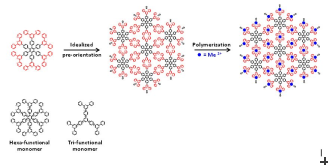Copyright 2012 neutronsources.org | All rights reserved. | Powered by FRM II | Imprint / Privacy Policy
Beyond Graphene
By A. Menelle, 16/05/2014
The creation of covalent monolayers with sufficient internal order and that exhibit reasonable mechanical strength has attracted much attention among synthetic chemists in the past few decades. Following the success of graphene, hailed as the champion prototype 2-D material, much effort has since been invested to go beyond graphene for alternative materials that offer more electronic and other functional flexibility; notable examples are hexagonal boron nitride and layered metal chalcogenides. These 2-D materials are usually produced by exfoliation or by harsh thermolytic processes that preclude the possibility for molecular design on demand. The team of Prof. D. Schlüter (ETHZ) pushes for a mild and facile and rational approach to the synthesis of new 2-D materials using specially-designed monomers to control internal pattern. These monomers are spread onto the air-water interface and pre-organized by isothermal compression, followed by in-situ photo-polymerization (anthracene-based monomer) or complexation with transition metal ions (terpyridine-based monomer). The 2-D polymer sheets are transferred onto silicon supports or metal grids for chemical and microscopy analyses, structural studies, and mechanical property evaluation. In this work, neutron reflectivity has been employed as the unique non-destructive technique to characterize the monolayer thickness throughout the entire preparation process: before and after polymerization of the monolayer at the free surface, the polymerized sheet transferred onto a solid support, and in a novel strategy for customizing 2-D organometallics, transmetallation of the monolayer.
Contact
Lay-Theng LEE (LLB)
Publications
Adv. Mater. 2014, 26, 2052–2058
J. Am. Chem. Soc. 2014, 136, 6103−6110
Highlights C&EN 2014, 92(14), 35
